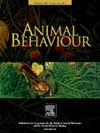整合运动数据和行为观察来评估同域清洁鱼的空间功能角色
IF 2.1
2区 生物学
Q2 BEHAVIORAL SCIENCES
引用次数: 0
摘要
移动生物在生态系统中的作用与它们利用空间的方式密切相关。然而,明确地将运动数据纳入海洋鱼类的功能评估尚未成为一种普遍的程序。在这里,我们结合了行为观察和详细的短期运动数据,这些数据来自于两种相关的和同属的清洁鱼Labroides dimidiatus和Labroides bicolor的GPS轨迹。我们揭示了这些互补的信息来源如何有助于阐明这些物种的功能角色。比较清洁动物运动轨迹的指标,可以发现不同物种在路径弯曲度和覆盖面积上的差异,但在总移动距离上没有差异。为了支持之前的文献,我们还发现这两个物种在整体清洁行为(例如,被检查客户的数量、身份和大小以及互动时间)上存在显著差异。无论其大小如何,L. dimidiatus在相对较小的区域建立了清洁站,并主要清理了小型客户物种。相比之下,双色l表现出特定尺寸的清洁策略,穿越更大的区域,主要清洁较大的客户物种。有趣的是,尽管覆盖的区域在大小上有很大不同,但两个物种的累计游泳距离相似。因此,尽管L. dimidiatus和L. bicolor的“领土”和“流动”清洁策略暗示了生态系统在空间尺度和可预测性方面的差异,但相似的距离表明这些策略的能量需求可能不太不协调。总的来说,我们的研究强调了在评估物种的功能作用时纳入运动的机会和意义。本文章由计算机程序翻译,如有差异,请以英文原文为准。
Integrating movement data and behavioural observations to assess the spatial functional role of sympatric cleaner fishes
The ecosystem role of mobile organisms is intimately linked with the way they use space. However, explicitly incorporating movement data in functional assessments of marine fishes has yet to become a common procedure. Here, we combine behavioural observations with detailed short-term movement data sourced from GPS tracks for two related and sympatric cleaner wrasses Labroides dimidiatus and Labroides bicolor. We reveal how these complementary sources of information may help clarify the functional roles of these species. Comparing indicators from the cleaners' movement trajectories revealed differences between species in both path tortuosity and area covered, but not for the total distance travelled. In support of previous literature, we also found that these two species differ sharply in their overall cleaning behaviour (e.g. number, identity and size of clients inspected and interaction time). Regardless of their size, L. dimidiatus established cleaning stations in relatively small areas and cleaned predominantly small client species. In contrast, L. bicolor exhibited size-specific cleaning strategies, travelled across vastly larger areas and cleaned primarily larger client species. Interestingly, despite covering areas that differed vastly in magnitude, both species swam similar cumulative distances. Thus, although the ‘territorial’ versus ‘roving’ cleaning strategies of L. dimidiatus and L. bicolor imply ecosystem roles that contrast in spatial scale and predictability, the similar distances swum suggest that the energetic requirements of these strategies may be less dissonant. Overall, our study highlights the opportunities and implications of incorporating movement when assessing the functional role of species.
求助全文
通过发布文献求助,成功后即可免费获取论文全文。
去求助
来源期刊

Animal Behaviour
生物-动物学
CiteScore
4.60
自引率
8.00%
发文量
236
审稿时长
10.2 weeks
期刊介绍:
Growing interest in behavioural biology and the international reputation of Animal Behaviour prompted an expansion to monthly publication in 1989. Animal Behaviour continues to be the journal of choice for biologists, ethologists, psychologists, physiologists, and veterinarians with an interest in the subject.
 求助内容:
求助内容: 应助结果提醒方式:
应助结果提醒方式:


